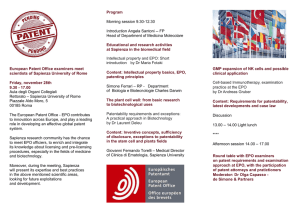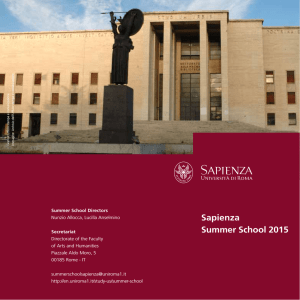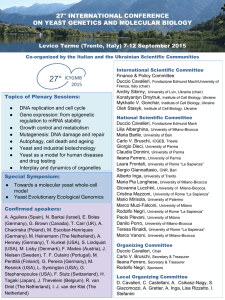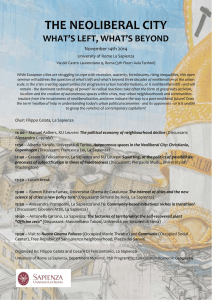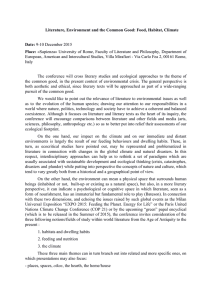H - e-learning
advertisement
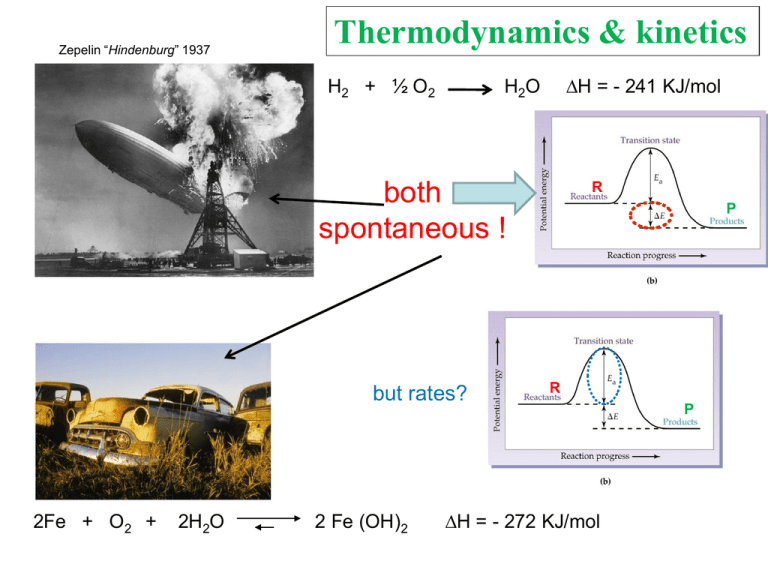
Zepelin “Hindenburg” 1937 Thermodynamics & kinetics H2 + ½ O2 H = - 241 KJ/mol H2O both spontaneous ! but rates? 2Fe + O2 + 2H2O 2 Fe (OH)2 R P R H = - 272 KJ/mol P Reaction coordinate Thermodynamics Deals with the relative stability of reactants and products Kinetics How long does it take to reach the transition state ? catalysis Paolo Sarti 2003 Dip. Scienze Biochimiche La Sapienza E Ea THERMODYNAMICS http://www.slideshare.net/Emersius/energy-changes Paolo Sarti 2011 Department of Biochemistry Sapienza A problem of relative energetic stability (P vs R) R P Paolo Sarti 2003 Dip. Scienze Biochimiche La Sapienza 2Fe + O2 + 2H2O 2 Fe (OH)2 Definition of a chemical system a) Isolated : no exchange of mass (m) and/or energy (E) dewar flask b) closed : no exchange of m with exchange of E reaction chamber c) open : exchange of both m ed E lab beaker, human body… Properties of matter (homogeneous) a) Intensive : independent on dimension b) extensive : dependent on dimension density, T, P etc. molar mass, volume, weight, etc. PRINCIPLES (meaning) I°: Energy conservation (Clausius 1865): energy is neither created or destroyed, it is converted. II° the Energy cannot be fully converted into useful work the total entropy (Entropy of universe SU) always increases III° the entropy value of a pure, perfect, cristal is (Nernst 1906) Paolo Sarti 2011 Department of Biochemistry Sapienza S = 0, a T = 0 K Parameters defining the energetic state of matter STATE FUNCTIONS: 1) 2) 3) 4) 5) INTERNAL ENERGY ENTHALPY ENTROPY FREE ENERGY TEMPERATURE Paolo Sarti 2011 Department of Biochemistry Sapienza U H S G T James Joule [1818-1889] INTERNAL ENERGY U U = the sum of all energetic contribution in a system (Ebonds; Ekinetic; Enuclear, etc.) U evaluation is difficult/impossible U can be evaluated through variation (U) of related parameters : 1) used/produced work [L; W] (changes in molecular structure) 2) heat exchange [Q] Paolo Sarti 2011 Department of Biochemistry Sapienza ENTHALPY (entalpo = heat up) easy… to measure Exothermic reaction (e.g. combustion…) R H = heat P + H (heat, Kcal/mol) 2H2 + O2 H = -H H 2H2O + 115 Kcal/mol -H +H heat is released heat is absorbed Endothermic reaction R + H +H P CaCO3 + 41 Kcal/mol CaO + CO2(gas) kilocalorie (Kcal) = large calorie = Cal = 1.000 calories 1 Kcal = 4,1868 Kilojoules (KJ) Paolo Sarti 2011 Department of Biochemistry Sapienza The calorie unit 1 (small) cal rises the temperature of 1 g H2O by 1 °C (from 14.5 to 15.5) (p = 1 atm) In biology, medicine, dietetics 1 Kcal (large Calorie, C) raises temperature of 1 Kg H2O by 1 °C (from 14.5 to 15.5 °C) 100 Kcal bring 1Kg of H2O to the boiling point (p= 1 atm) 1 cal ~ 4.18 joules Paolo Sarti 2011 Department of Biochemistry Sapienza exothermic - endothermic reactions Heat is released Paolo Sarti 2011 Department of Biochemistry Sapienza Heat is absorbed Hess Law : the enthalpy variation (ΔH) for the reaction converting reactants (SM) into products (P) Is independent on the reaction pathway(s). Prof. Hess S. Petersburg (1830) Paolo Sarti 2011 Department of Biochemistry Sapienza The reaction (overall) is exothermic The “Reaction Heat” calorimeter Paolo Sarti 2011 Department of Biochemistry Sapienza +H = heat is absorbed to break the solute reticulum-bonds and to separate the solvent molecules H1 + H2 - H = heat is released in the solute hydration process H3 H sv+st H1 + H2 sv ; st Htot H3 solution time Solubilization H Kcal/mole Paolo Sarti 2011 Department of Biochemistry Sapienza solute NaCl +H1,2 186 - H3 185 Htot +1 ? NaOH 176 186 -10 ? NH4Cl 152.6 149 +3.6 ? Solubility (a.u.) Effect of temperature on solubility H+ HTemperature (a.u.) Paolo Sarti 2011 Department of Biochemistry Sapienza Equilibrium and Enthalpy H = heat +H A + B +H C + D -H +H CaCO3 + H CaO + CO2(gas) + H 41 Kcal/mol - H 41 Kcal/mol -H Can an endothermic reaction (+H) be spontaneous?! Paolo Sarti 2011 Department of Biochemistry Sapienza Yes Owing to the (+) Entropy contribution! ENTROPY Aggregation states and Entropy Paolo Sarti 2011 Department of Biochemistry Sapienza diamond Paolo Sarti 2011 Department of Biochemistry Sapienza NaClcrist. ≈ 2 u.e. NaClgas ≈ 40 u.e. Paolo Sarti 2011 Department of Biochemistry Sapienza +S N2O4 2NO2 -H Paolo Sarti 2011 Department of Biochemistry Sapienza System Entropy (Ssy) & Surroundings Entropy (Ssu) Ssu -H / T Paolo Sarti 2011 Department of Biochemistry Sapienza H1,2 = 0 Entropy & Spontaneity 1 2 S2 - S1 >> 0 S = + Paolo Sarti 2011 Department of Biochemistry Sapienza of a reaction Entropy (S) [Sady Carnot] S = is a measure of disorder (randomness) 2 components Reagents and Products surroundings Ssu Ss Ss = KBzln W -H / T KBz1.38062 x 10−23 (joule/kelvin) Stot,univ = Ss + Ssu W = n° of molecular microstates KBz = Boltzman constant Paolo Sarti 2011 Department of Biochemistry Sapienza H & S & Spontaneous processes Do spontaneous endothermic reactions exist (+H)? Yes (e.g. salt solubilization ) Ssy increases Do spontaneous reactions with decreasing-entropy exist (-S)? Yes (e.g. crystallization) why ? increases the surrounding entropy Ssu A relationship between disorder of a system And the heat exchanged with surroundings H ≡ Ssu Must exist At a given temperature Accounting for spontaneity G = H - TS Paolo Sarti 2011 Department of Biochemistry Sapienza Gibbs Equation Gibbs 1863 Yale University G = Gibbs, the free energy (to produce work) (by convention) G is negative (- G) when the reaction occurs spontaneously and energy can be used up (doing work) Stot = Ssu + Ssy Ssu = -H/T assuming (given the same enthalpy change( –H) the lower the T, the bigger is Ssu) Ssy S Stot = -H/T + S -TStot = H - TS (by multiplying for T and changing the sign) now we define as the Gibbs free energy –TStot = G G = H - TS Paolo Sarti 2011 Department of Biochemistry Sapienza G = H - TS spontaneous process G < 0 When does G < 0 ? 1) H negative & S positive 2) Both S & H are negative, but H has an absolute value bigger than TS 3) H positive, S positive & TS > H The reactions occurring in our body are very often Entropy driven !!! Paolo Sarti 2011 Department of Biochemistry Sapienza Free Energy & Equilibrium on aA + bB cC + dD off [C]c [D]d Keq =-----------[A]a [B]b High values of Keq = reaction shifted to the right Low values of Keq = reaction shifted to the left G and Keq (Van’t Hoff equation) G = (-RT lnKeq + RT ln Q) = For Q Keq ? Paolo Sarti 2003 Dip. Scienze Biochimiche La Sapienza G = 0 RT ln Q/Keq

